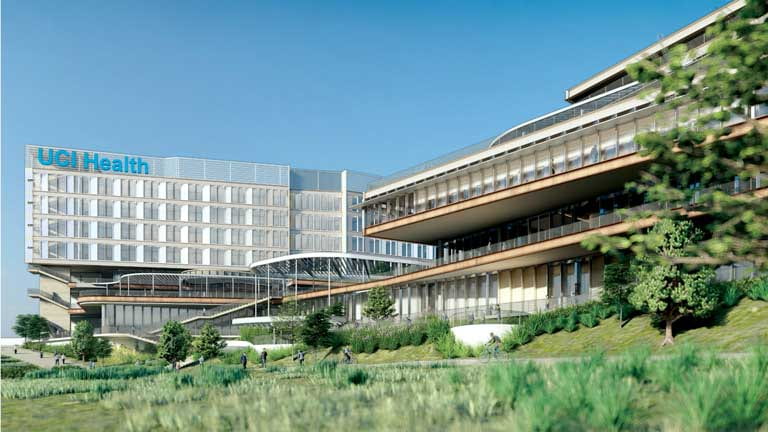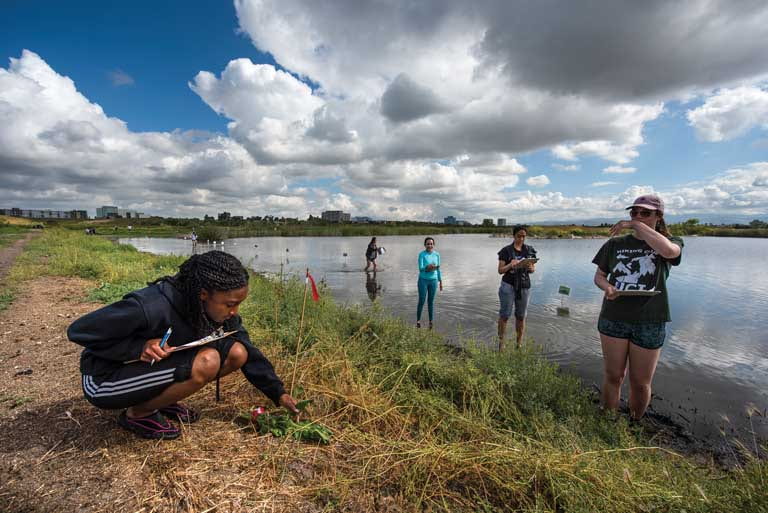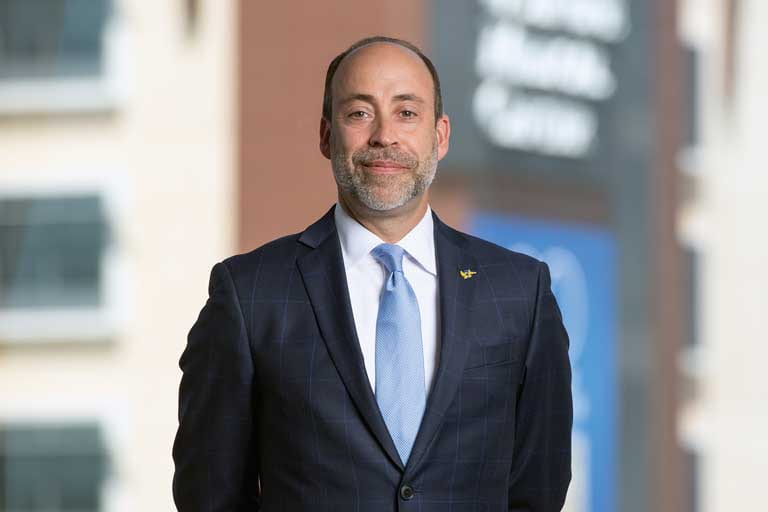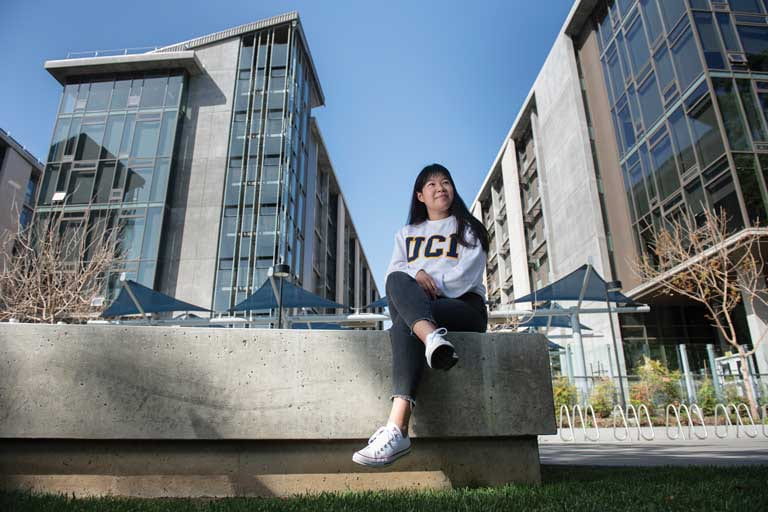Meeting the Future
With plans for a new medical complex and college of health sciences underway, UCI continues its evolution to help the individual and the broader community
Rebar and steel girders rising at UCI signal a new era in the campus’s growth and healthcare profile. Never shy of a challenge, UCI is emerging from a year defined by COVID-19, realizing a decades-long vision fueled by medical and managerial lessons learned during that time. The clear message: When a once-in-a-century pandemic throws a wrench into the world, use it to build something worthy of transforming lives for the next generation.
Taking that to heart, UCI has embarked on a building boom that incorporates its expertise in technology, green energy and eco-friendly design and fulfills commitments to healthcare and wellness and world-changing research articulated in the university’s $2 billion Brilliant Future fundraising campaign.
The strategic growth spurt began with the new Interdisciplinary Science and Engineering Building, which opened in December 2020. Meanwhile, funding and development continues on a permanent home for the UCI Institute and Museum of California Art.
Two combined healthcare projects kicked off in November 2020, when the campus broke ground on a landmark, 9-acre health sciences complex at Bison and California avenues. That project will be joined by the construction of a new medical center that will anchor the northern edge of university property.
“We knew when I came here in 2013 that we would get bigger, but we’re not growing just to grow,” says UCI Chancellor Howard Gillman. “We’re continuing to grow in a way that has impact – on our student body, on the community and in the world – with our research and with a vision of health sciences that’s different from what we had originally. We’re realizing a unique opportunity among all of American higher education to build out in accordance with our special mission of working together to serve the whole person and community.”
For Dr. Steven Goldstein, vice chancellor for health affairs, the combined projects position UCI to serve all of Orange County’s 3.2 million people and provide leadership in the future of healthcare excellence, equity, access, precision and cost control. Accomplishing all that will require collaboration from STEM fields, humanities, arts, social sciences and more – a multidisciplinary approach that has become UCI’s hallmark.
Health Center
An academic medical facility serving coastal and southern Orange County

A hospital as hub for research, teaching and healing on the UCI campus realizes the dream born when President Lyndon B. Johnson landed in a helicopter a short distance away from the corner of Jamboree Road and Campus Drive 57 years ago to dedicate the land upon which the university would rise. Construction on the UCI Medical Center in Irvine is expected to begin in the latter half of 2021 and be completed in two phases between 2022 and 2025. Philanthropic donations, health operations revenue and loans will fund the $1.2 billion project.
The plans anticipate demographic changes – including 30 percent growth in those over the age of 65, the population most in need of healthcare – during the next four decades. The new medical campus will allow the community to stay ahead of the demand for the cutting-edge services provided by an academic health center. The COVID-19 pandemic and its associated challenges also highlight the need for the facilities, Goldstein says.
“The only way to offer the best possible care – now and in the future – is through our mission to discover, teach and heal,” he says. “This new medical center is a central star in that process. The discovery domain includes services like advanced cancer trials, where our patients can benefit from new therapies only available at National Cancer Institute-designated Comprehensive Cancer Centers, like our Chao Family Center. As teachers, we also lead the nation, educating health innovators who form the backbone of the diverse workforce of the future. And this new health campus allows us to continue to attract world-leading physicians, nurses, pharmacists and population health experts to Orange County who promote healing in the most advanced ways.”
The new medical complex will grow from what has been the peripheral nervous system of the campus since its founding – most recently home to facilities management, transportation and distribution services, and the UCI Arboretum, which will be relocated as part of a new campus “naturescape” project.
Phase one is the 168,000-square-foot UCI Health Center for Advanced Care, which comprises the Center for Children’s Health, wellness programs, outpatient specialty disciplines and clinical trials in cancer infusion. Phase two is a 144-bed acute care hospital and the Chao Family Comprehensive Cancer Center and Ambulatory Care, focused on oncology, neurosciences, orthopedics, and spine and digestive health, along with emergency services. Opening for the combined 632,000 square feet is planned for 2025.
Buildings will incorporate sustainable construction and green technology. Low-water-demand plantings and recycled water for irrigation will mitigate water use. High-performance glazing and building insulation, efficient lighting and air conditioning, and other measures will exceed California energy efficiency requirements by at least 20 percent. Electric heating and cooling systems will be served by UC green power – a system of renewable power sources.
“The only way to offer the best possible care –
now and in the future – is through our mission to
discover, teach and heal.”
More visible to patients will be the many innovations in patient-based healing. Imagine cancer infusion suites with expansive views of marshland preserves and outdoor porches that give patients access to the healing power of nature, Goldstein says. Crowded waiting rooms are part of the pre-pandemic past. Instead, patients will find options for outdoor waiting areas and technologically advanced diagnostic hubs. And from intensive care to step-down units, patients will stay in one bed and caregivers will rotate as required, eliminating the need to transfer people from room to room.
New technology will allow medical teams to leverage UCI’s unique expertise in artificial intelligence to assess care needs. During the COVID-19 pandemic, UCI Health doctors entered patient data into a vulnerability algorithm that predicted who would most likely require intensive care and intubation and advised how best to treat each patient to avoid that outcome.
“The system was so successful that the U.S. Department of Health and Human Services asked us to share it nationwide, and we were proud to do so,” Goldstein says.
“These buildings and UCI’s growth at other medical sites throughout the region are designed for the future,” he notes. “Like the cutting-edge clinical care delivered at UCI Medical Center in Orange, the new health center on the main UCI campus will offer the very best patient-focused care and support for lifelong wellness.”
STATS
Acres: 222, including the medical center, a healing garden and the marsh reserve
Buildings: 3, including a 144-bed acute care hospital, cancer center and ambulatory care services, and the UCI Health Center for Advanced Care, home to children’s services and medical specialties
Square feet: 800,000 combined, with 64,400 square feet of reserved build-out space for future projects
Parking: 1,350 spaces
Jobs created: 2,500 in construction and staffing
Community health benefits: Serving an expected double-digit increase in Orange County population, with 30 percent growth in those over age 65
Cost: $1.2 billion combined, funded by philanthropic donations, health operations revenue and loans
Special features: Includes the Chao Family Comprehensive Cancer Center and Ambulatory Care, one of only 51 nationally designated centers; and offers advanced technology such as artificial intelligence patient vulnerability algorithm programs that allow analysis of patient data to assess best practices for treatment. The cancer care center is strategically located at the new medical center campus in Irvine to allow patients to receive multidisciplinary care by interprofessional and integrative teams working together to apply the latest innovations from university-backed clinical research.
Health Sciences Complex
A national beacon of integrated care

Just a short walk away from the campus medical center, a teaching facility is rising on 9 acres at the corner of Bison and California avenues. It will stand as a testament to UCI’s commitment to integrated healthcare.
The 135,111-square-foot, five-floor Susan & Henry Samueli College of Health Sciences building will be home to students in medicine, pharmaceutical sciences, and population and public health and will provide headquarters for the Susan Samueli Integrative Health Institute. The adjoining Sue & Bill Gross School of Nursing, with 77,028 square feet over four floors, will complete the construction. The complex is expected to open in 2022 and is budgeted at $134 million.
“These two new buildings, part of our expanded health sciences campus, are designed to foster the creation of the team-based, precision healthcare workers of tomorrow,” Goldstein says. “The facilities will enable interprofessional education and train care providers to operate in synchrony.”
Sharing space with the integrative health institute will allow students to incorporate its focus on wellness and the whole person. The institute aims to discover and promote effective, evidence-based practices that optimize well-being. Students will be trained to evaluate both conventional and complementary therapies, such as nutrition for long-term health, acupuncture as an alternative to addictive opioids for pain control, and meditation as a method of stress reduction.
“These two new buildings, part of our expanded
health sciences campus, are designed to foster
the creation of the team-based, precision healthcare
workers of tomorrow. The facilities will enable
interprofessional education and train care
providers to operate in synchrony.”
The health sciences complex taking advantage of UCI’s unique open space will fulfill the human desire to interact with nature by providing access to light, airy views of vegetation and water and walking trails. The integration of physical locations with natural habitats is deeply rooted in a vision set forth by founding Chancellor Dan Aldrich Jr. to nurture the building of UCI. The design also features a 150-seat auditorium, a central courtyard that connects to the existing Gavin Herbert Eye Institute, spaces for encouraging such health activities as yoga and tai chi in nature, a Zen garden, and a 600-foot-long wellness walk that leads to the School of Medicine’s Biomedical Research Center.
Susan and Henry Samueli donated $200 million in part to build this first-of-its-kind college of health sciences focused on interdisciplinary healthcare and whole-person care.
“We are very excited for the UCI College of Health Sciences to become a national model for integrative health,” Henry Samueli said at the time of the donation – one of the largest ever to a public university. “We believe this model will eventually become the standard approach for promoting health and well-being in our society.”
The William and Sue Gross Family Foundation committed $40 million to establish a nursing school and assist in the construction of a building to house it.
STATS
Acres: 9
Buildings: 2 – the Susan & Henry Samueli College of Health Sciences and the Sue & Bill Gross School of Nursing
Square feet: 212,139 combined
Students served: Medical, nursing, pharmacy and pharmaceutical sciences, population and public health, and integrative health
Cost: $134 million, funded by philanthropic donations
Special feature: Serves as a national model for promoting team-based care and integrative medicine
Naturescape/Public Gardens
A living laboratory

UCI’s substantial open space, which distinguishes it from most other major research universities, has given a 15-member Naturescape Advisory Committee the opportunity to redefine the concept of “outdoors” at UCI and transform the stewardship of the campus’s open and wildland resources to enhance the university’s mission.
The vision – defined by a multidisciplinary faculty/staff committee co-chaired by Richard Demerjian, assistant vice chancellor for campus physical & environmental planning, and Travis Huxman, professor of ecology & evolutionary biology – is a campuswide garden that reflects the area’s human and biological heritage. Like the UCI Arboretum before them, the public gardens, learning centers, experimental sites and more will support teaching, research and community engagement.
UCI’s naturescape emanates from the center of the campus, linking research, ecology, hydrology, wellness and art radially, reaching outward into academic plazas and greenbelts. The public gardens vision highlights five major plant collections representing the state’s Mediterranean-climate ecosystem. It celebrates the biodiversity of native plants in the California garden, which will be flanked by four additional gardens representing the Western Cape, Chilean, Mediterranean and Australian biomes.

The university’s core will connect to the new medical complex at UCI’s northern edge via the North Campus Health and Wellness Trail. Traversing the 202-acre, UC-operated San Joaquin Marsh Reserve, outside a protected 150-foot biological buffer zone, the 1-mile pedestrian and bicycle path will feature two outdoor classrooms, information kiosks, research plots and shaded overlooks. Designed to be open to the community, the trail will be fenced to protect sensitive marsh habitat. Its southern end will meet the San Diego Creek bridge, seamlessly linking the central campus to the marsh.
Gillman credits campus leaders’ bold strategic plan – one that captured the strong aspirations of the UCI community – for the ambitious new growth spurt.
“Everyone has agreed that we don’t look for incremental growth,” he says. “We look for big leaps that are specifically linked to a distinct vision and a different way of thinking.”



